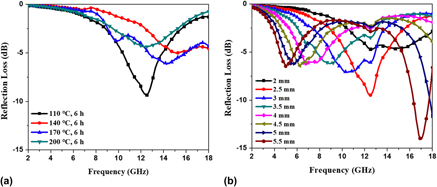Crossref Citations
This article has been cited by the following publications. This list is generated based on data provided by
Crossref.
Wang, Zixuan
Yu, Qi
Nie, Weicheng
and
Chen, Ping
2020.
Preparation and microwave absorption properties of Ni/rGO/EP composite foam.
Journal of Materials Research,
Vol. 35,
Issue. 16,
p.
2106.
Liu, Peijiang
Chen, Shuixian
Yao, Min
Yao, Zhengjun
Ng, Vincent Ming Hong
Zhou, Jintang
Lei, Yiming
Yang, Zhihong
and
Kong, Ling Bing
2020.
Double-layer absorbers based on hierarchical MXene composites for microwave absorption through optimal combination.
Journal of Materials Research,
Vol. 35,
Issue. 11,
p.
1481.
Tian, Konghu
Shu, Ruiwen
and
Zhao, Chenglu
2021.
Synthesis of trimanganese tetroxide nanoparticles decorated nitrogen-doped reduced graphene oxide composite aerogels with excellent microwave absorption performance.
Diamond and Related Materials,
Vol. 120,
Issue. ,
p.
108705.
Bose, Vipin C.
Sugathan, Neena
and
Biju, V.
2021.
Novel sol–gel method for low temperature synthesis of nanostructured Mn3O4: Structure, cation valence states, optical and electrical properties.
Journal of Crystal Growth,
Vol. 555,
Issue. ,
p.
125961.
Chen, Xiaojun
Liu, Hongyang
Hu, Dechao
Liu, Huaqing
and
Ma, Wenshi
2021.
Recent advances in carbon nanotubes-based microwave absorbing composites.
Ceramics International,
Vol. 47,
Issue. 17,
p.
23749.
Duan, Yuping
Gao, Minmin
Pang, Huifang
and
Wang, Tongmin
2021.
FeCoNiMnAl high-entropy alloy: Improving electromagnetic wave absorption properties.
Journal of Materials Research,
Vol. 36,
Issue. 10,
p.
2107.
Gao, Jiangshan
Wang, Huanhuan
Zhou, Yang
Liu, Zhiming
and
He, Yan
2022.
Self-template and in-situ synthesis strategy to construct MnO2/Mn3O4@Ni-Co/GC nanocubes for efficient microwave absorption properties.
Journal of Alloys and Compounds,
Vol. 892,
Issue. ,
p.
162151.
Ge, Chuannan
Lei, Chenglong
Wang, Bo
Wang, Yakun
and
Peng, Zhouhao
2022.
Hydrothermal synthesis flaky FeSiAl/Mn3O4 composites with enhanced Ku-band microwave absorption.
Journal of Materials Science,
Vol. 57,
Issue. 36,
p.
17325.
Heydaryan, Kamran
Mohammadalizadeh, Mohsen
Montazer, Amir H.
and
Almasi Kashi, Mohammad
2023.
Reaction time-induced improvement in hyperthermia properties of cobalt ferrite nanoparticles with different sizes.
Materials Chemistry and Physics,
Vol. 303,
Issue. ,
p.
127773.
Pu, Liwei
Zhu, Yongfeng
Xiong, Qingang
Mo, Lihuan
and
Liu, Xiaowen
2024.
Efficient removal of 4-chlorophenol by activation of peroxymonosulfate with synthesized high-performance MnOx/CBC catalysts.
Journal of Environmental Chemical Engineering,
Vol. 12,
Issue. 6,
p.
114746.
Zheng, Yanfei
Xu, Weinuo
Yang, Jining
Shan, Cangpeng
Wang, Yunchong
Han, Rui
Zang, Guolong
and
Liu, Qingling
2024.
Catalytic oxidation of VOCs and CO on cobalt-based Materials: Strategies and mechanisms for improving activity and stability.
Chemical Engineering Journal,
Vol. 484,
Issue. ,
p.
149296.



